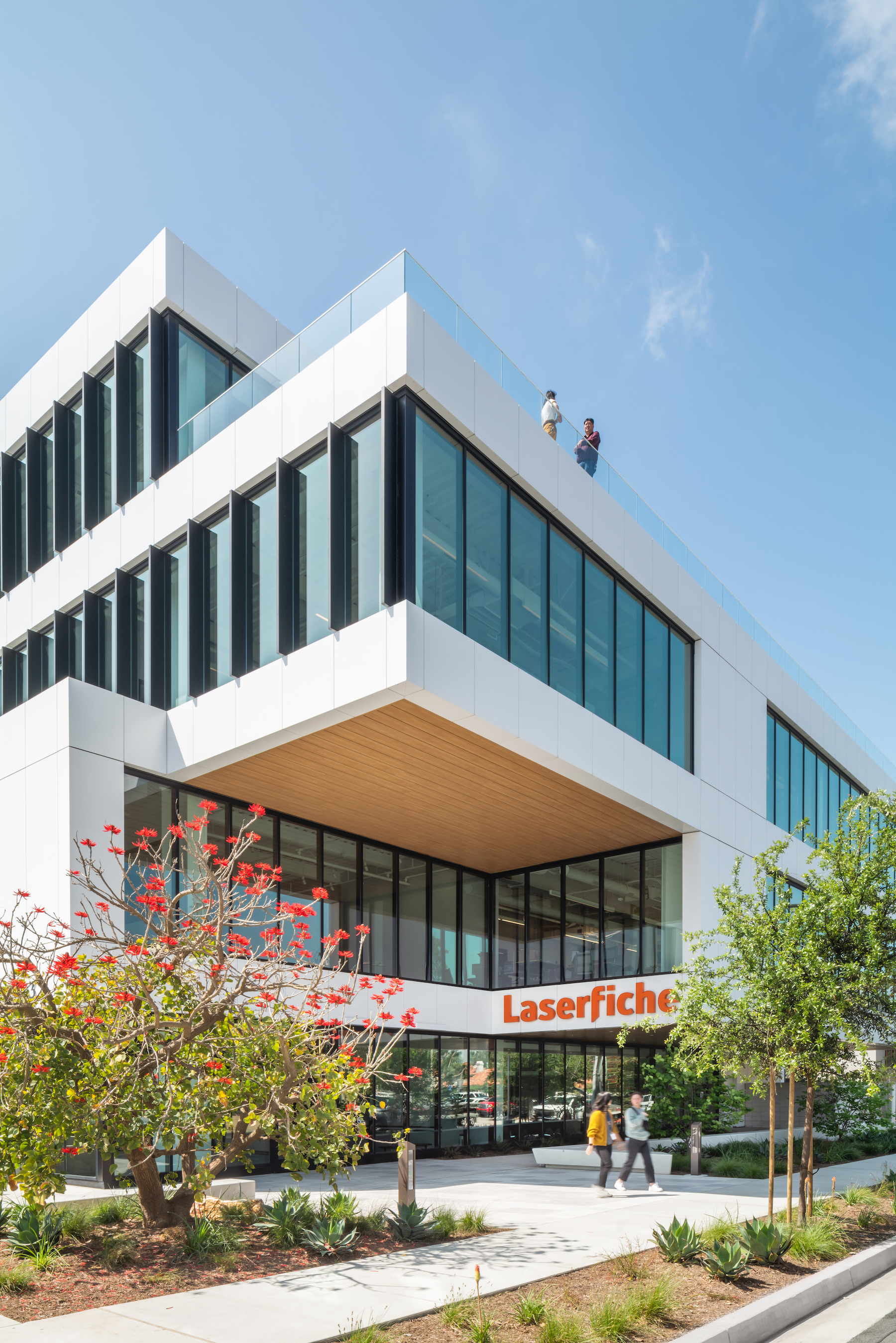The new Long Beach, Calif., headquarters of Laserfiche, a provider of intelligent content management and business process automation software, was built on a brownfield parcel previously considered undevelopable. The project began with capping eight abandoned oil wells and included the removal of several storage tanks. The 102,840 sf development consists of four floors and a parking garage. The building can accommodate 550 full time in-office employees, or up to 750 hybrid workers.
Constructed on a prominent corner of a new tech corridor in northern Long Beach, the building’s design gives nods to a garden office structure across the street designed by Mid-Century Modern architect Ed Killingsworth. The scale and style of that iconic building provided a design reference point. The massing of the structure is turned 90 degrees and stepped back at the upper floors to relate to the scale of the garden office. The upper floors then slide to shade the building on the south face and create decks on the north face for socializing and connecting to nature via treetops and mountain views.
The building core is located on the west facade to minimize the need for windows, resulting in a dramatic reduction of afternoon heat gain. Moving the core from the center of the building to the western edge also created an expansive connected work area providing flexibility in the work environment. Two locations have dramatic double height spaces. One, located at the entry, provides for a two story “outdoor porch” and lobby with a tranquility koi pond. The second location, called “Skylab,” is positioned on the top floor with views of downtown Long Beach, the Pacific Ocean, and the Palos Verdes Peninsula. This a flexible “ideation space” for employee teams and serves as a beacon to motorists traveling on the busy 405 Freeway.
Each floor features individual work areas, large and small conference spaces, and expansive flex areas that can be rearranged with mobile furniture. Wide and naturally lit stairwells connect all levels, providing inviting passageways that encourage use to promote health and wellness. Natural wood, stone, and concrete paired with the brand color of dark blue and distinctive orange guide and define the palette.
The project aimed for LEED Platinum. The design considers water consumption and rainwater retention, as well as energy uses, air quality, and ventilation. Vertical and horizontal fins increase energy efficiency and promote thermal comfort by providing solar shading to the building. All employees have access to natural light at their workstations.
On the Building Team:
Owner and/or developer: Laserfiche
Design architect: Studio One Eleven
Architect of record: Studio One Eleven
MEP engineer: Southland Engineering
Structural engineer: Structural Focus
General contractor/construction manager: Millie & Severson
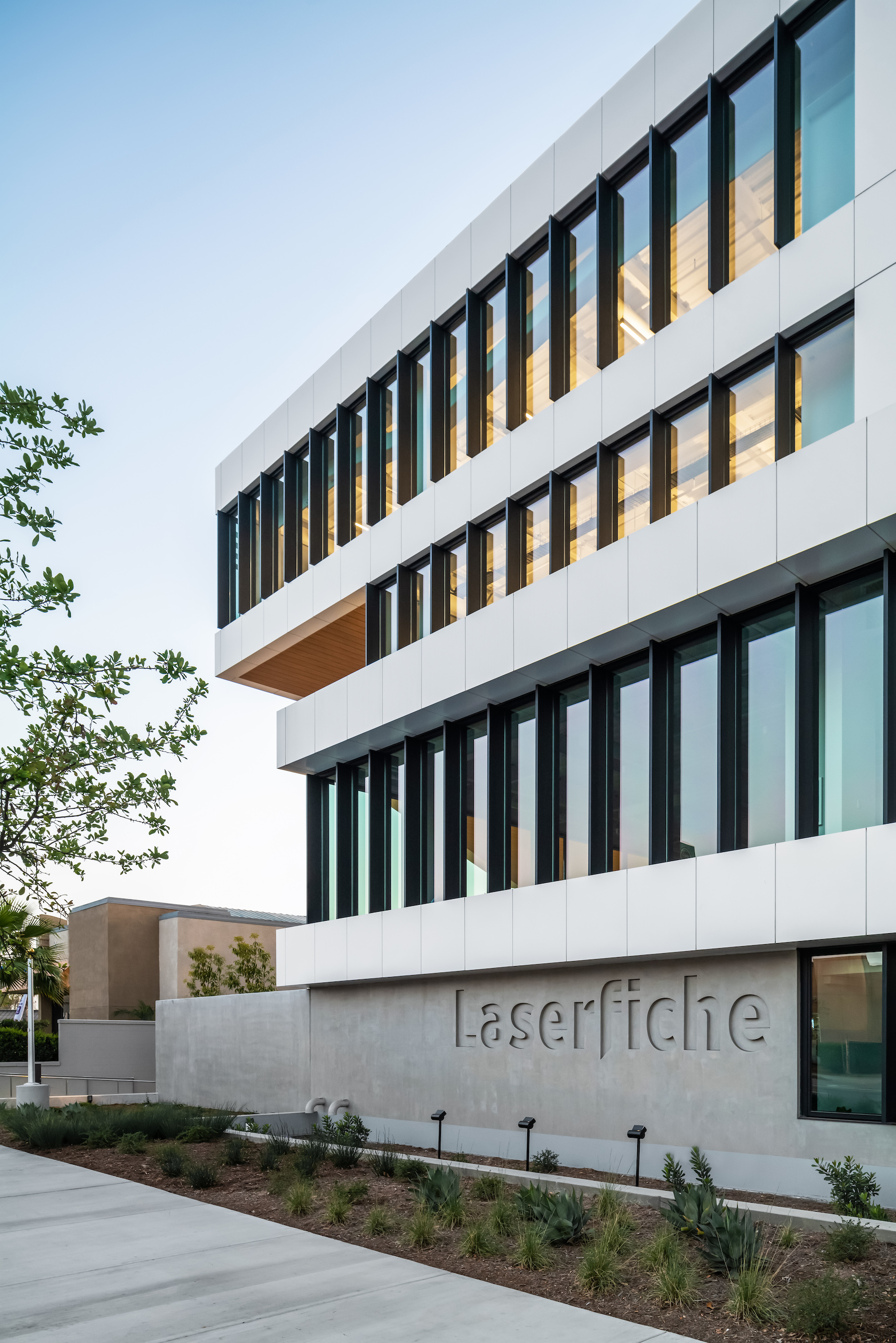
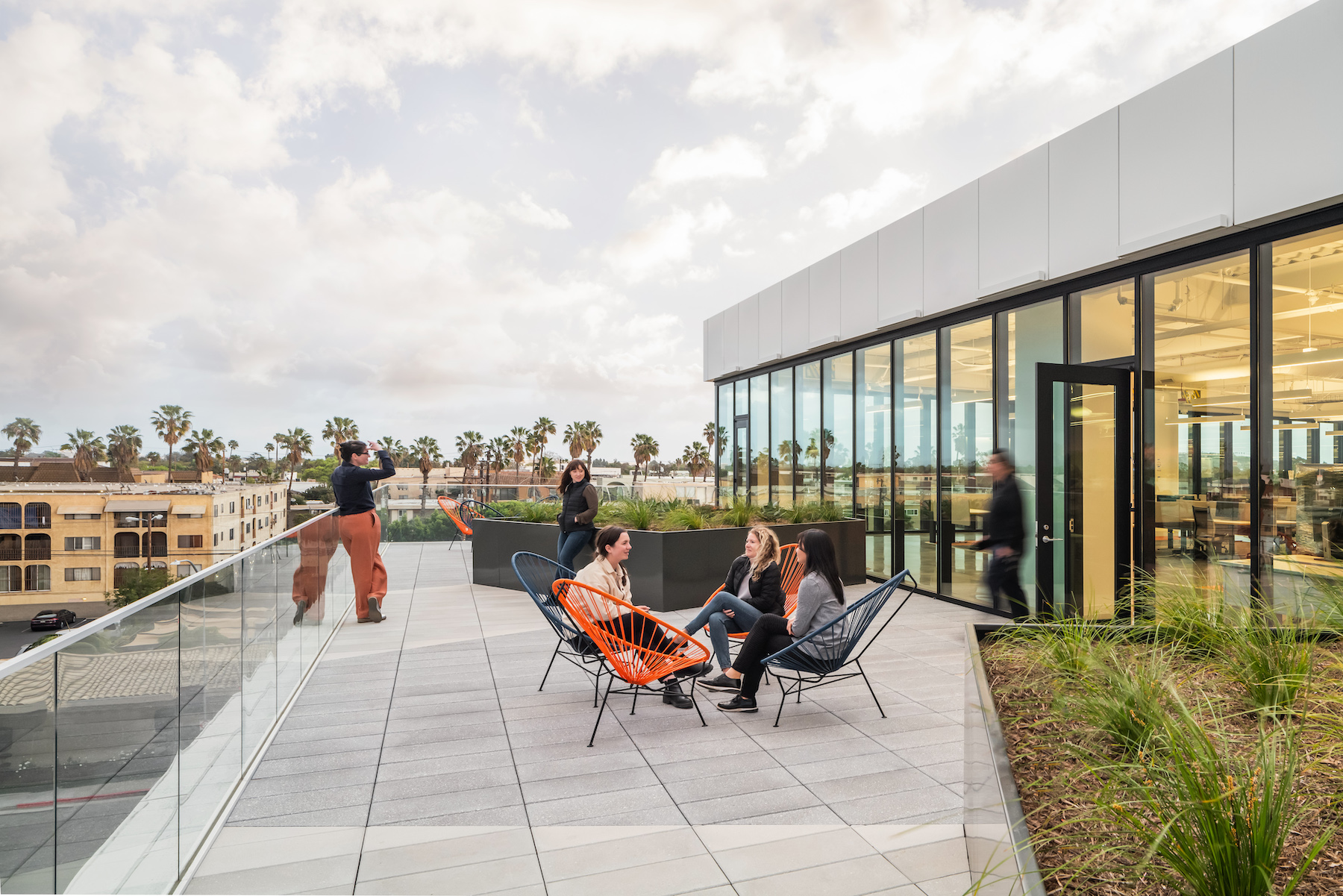
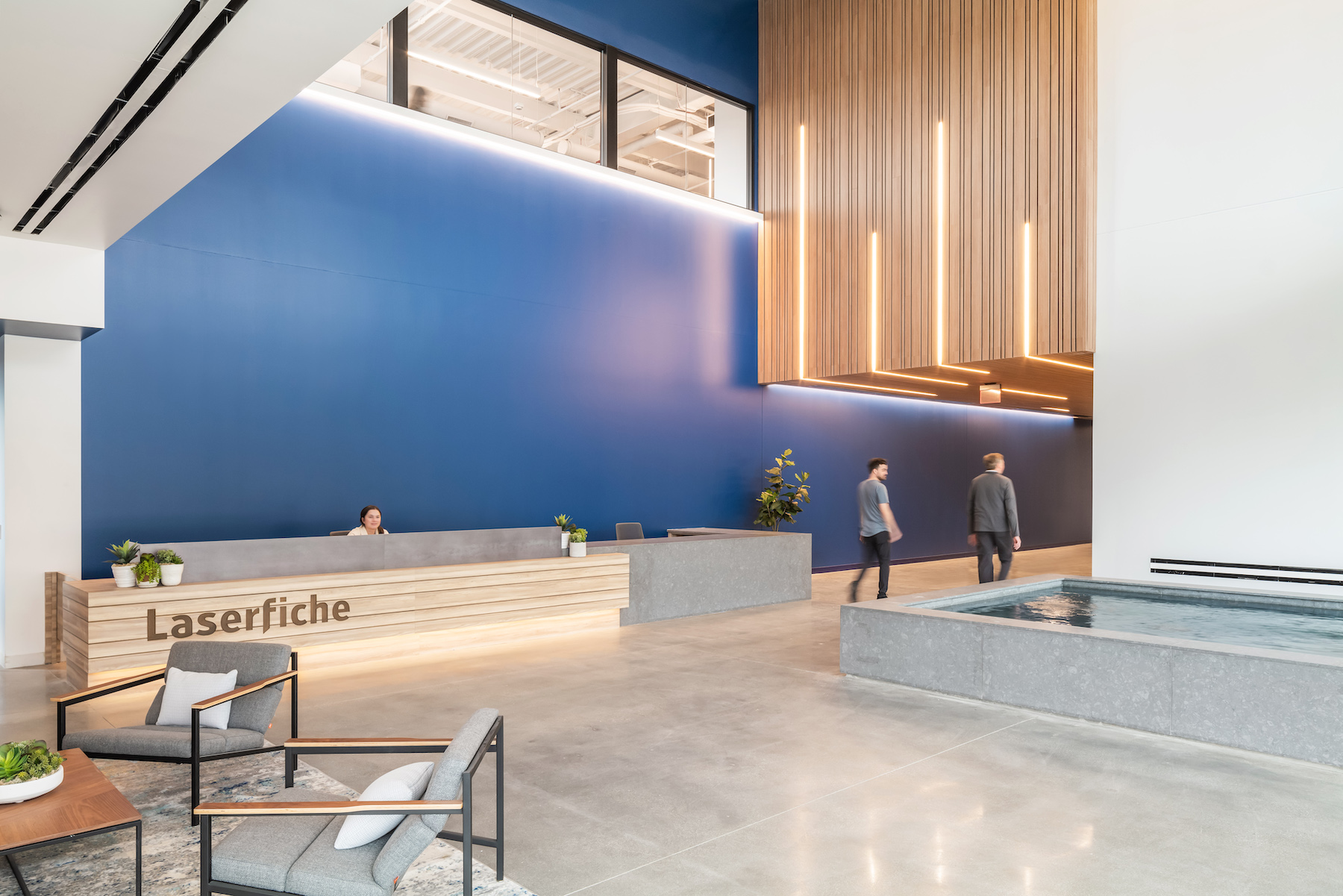
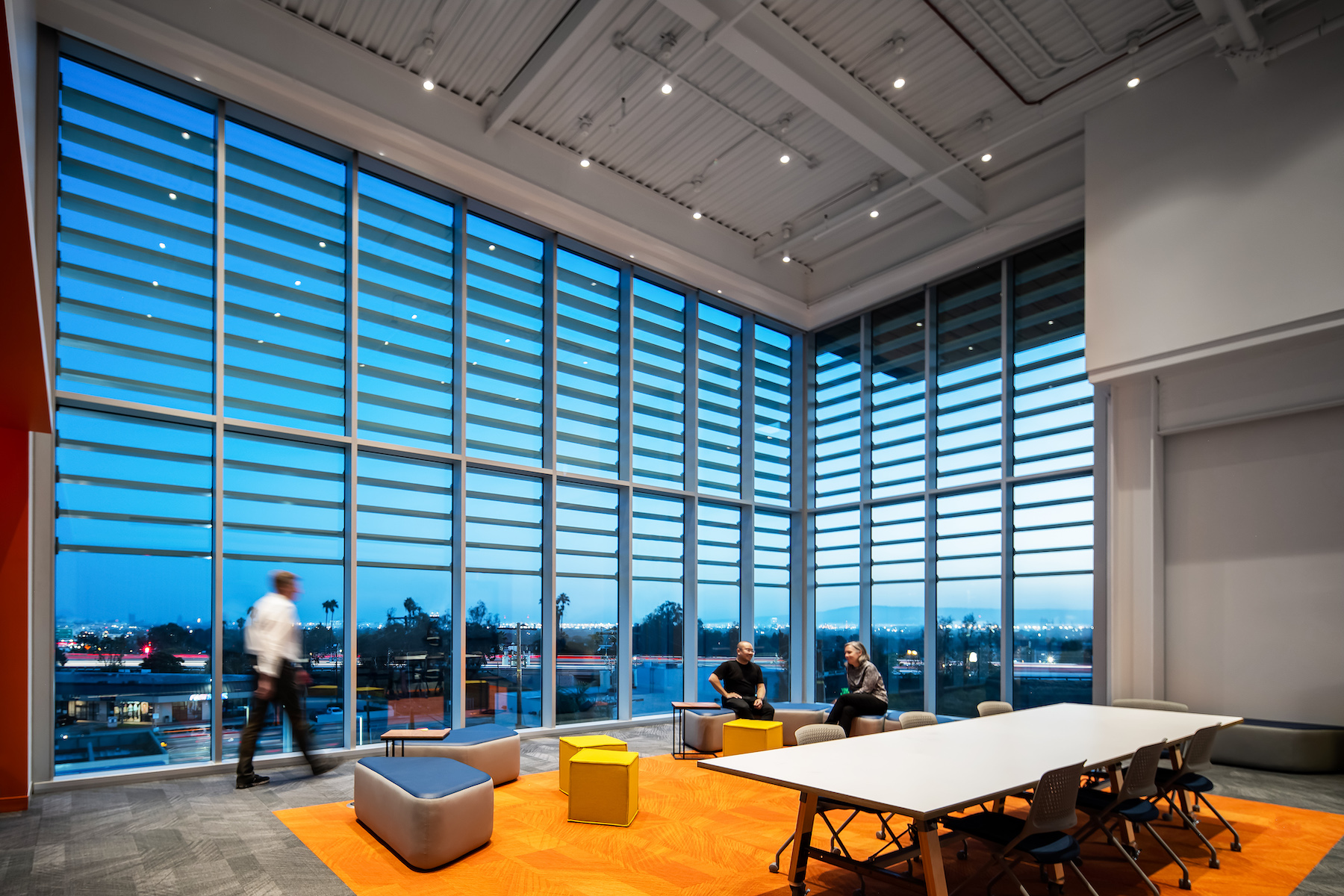
Related Stories
| Aug 11, 2010
AIA Course: Enclosure strategies for better buildings
Sustainability and energy efficiency depend not only on the overall design but also on the building's enclosure system. Whether it's via better air-infiltration control, thermal insulation, and moisture control, or more advanced strategies such as active façades with automated shading and venting or novel enclosure types such as double walls, Building Teams are delivering more efficient, better performing, and healthier building enclosures.
| Aug 11, 2010
Glass Wall Systems Open Up Closed Spaces
Sectioning off large open spaces without making everything feel closed off was the challenge faced by two very different projects—one an upscale food market in Napa Valley, the other a corporate office in Southern California. Movable glass wall systems proved to be the solution in both projects.
| Aug 11, 2010
Silver Award: Pere Marquette Depot Bay City, Mich.
For 38 years, the Pere Marquette Depot sat boarded up, broken down, and fire damaged. The Prairie-style building, with its distinctive orange iron-brick walls, was once the elegant Bay City, Mich., train station. The facility, which opened in 1904, served the Flint and Pere Marquette Railroad Company when the area was the epicenter of lumber processing for the shipbuilding and kit homebuilding ...
| Aug 11, 2010
Special Recognition: Durrant Group Headquarters, Dubuque, Iowa
Architecture firm Durrant Group used the redesign of its $3.7 million headquarters building as a way to showcase the firm's creativity, design talent, and technical expertise as well as to create a laboratory for experimentation and education. The Dubuque, Iowa, firm's stated desire was to set a high sustainability standard for both itself and its clients by recycling a 22,890-sf downtown buil...
| Aug 11, 2010
Thrown For a Loop in China
While the Bird's Nest and Water Cube captured all the TV coverage during the Beijing Olympics in August, the Rem Koolhaas-designed CCTV Headquarters in Beijing—known as the “Drunken Towers” or “Big Shorts,” for its unusual shape—is certain to steal the show when it opens next year.
| Aug 11, 2010
Top of the rock—Observation deck at Rockefeller Center
Opened in 1933, the observation deck at Rockefeller Center was designed to evoke the elegant promenades found on the period's luxury transatlantic liners—only with views of the city's skyline instead of the ocean. In 1986 this cultural landmark was closed to the public and sat unused for almost two decades.
| Aug 11, 2010
200 Fillmore
Built in 1963, the 32,000-sf 200 Fillmore building in Denver housed office and retail in a drab, outdated, and energy-splurging shell—a “style” made doubly disastrous by 200 Fillmore's function as the backdrop for a popular public plaza and outdoor café called “The Beach.
| Aug 11, 2010
Integrated Project Delivery builds a brave, new BIM world
Three-dimensional information, such as that provided by building information modeling, allows all members of the Building Team to visualize the many components of a project and how they work together. BIM and other 3D tools convey the idea and intent of the designer to the entire Building Team and lay the groundwork for integrated project delivery.
| Aug 11, 2010
Inspiring Offices: Office Design That Drives Creativity
Office design has always been linked to productivity—how many workers can be reasonably squeezed into a given space—but why isn’t it more frequently linked to creativity? “In general, I don’t think enough people link the design of space to business outcome,” says Janice Linster, partner with the Minneapolis design firm Studio Hive.
| Aug 11, 2010
Great Solutions: Products
14. Mod Pod A Nod to Flex Biz Designed by the British firm Tate + Hindle, the OfficePOD is a flexible office space that can be installed, well, just about anywhere, indoors or out. The self-contained modular units measure about seven feet square and are designed to serve as dedicated space for employees who work from home or other remote locations.


